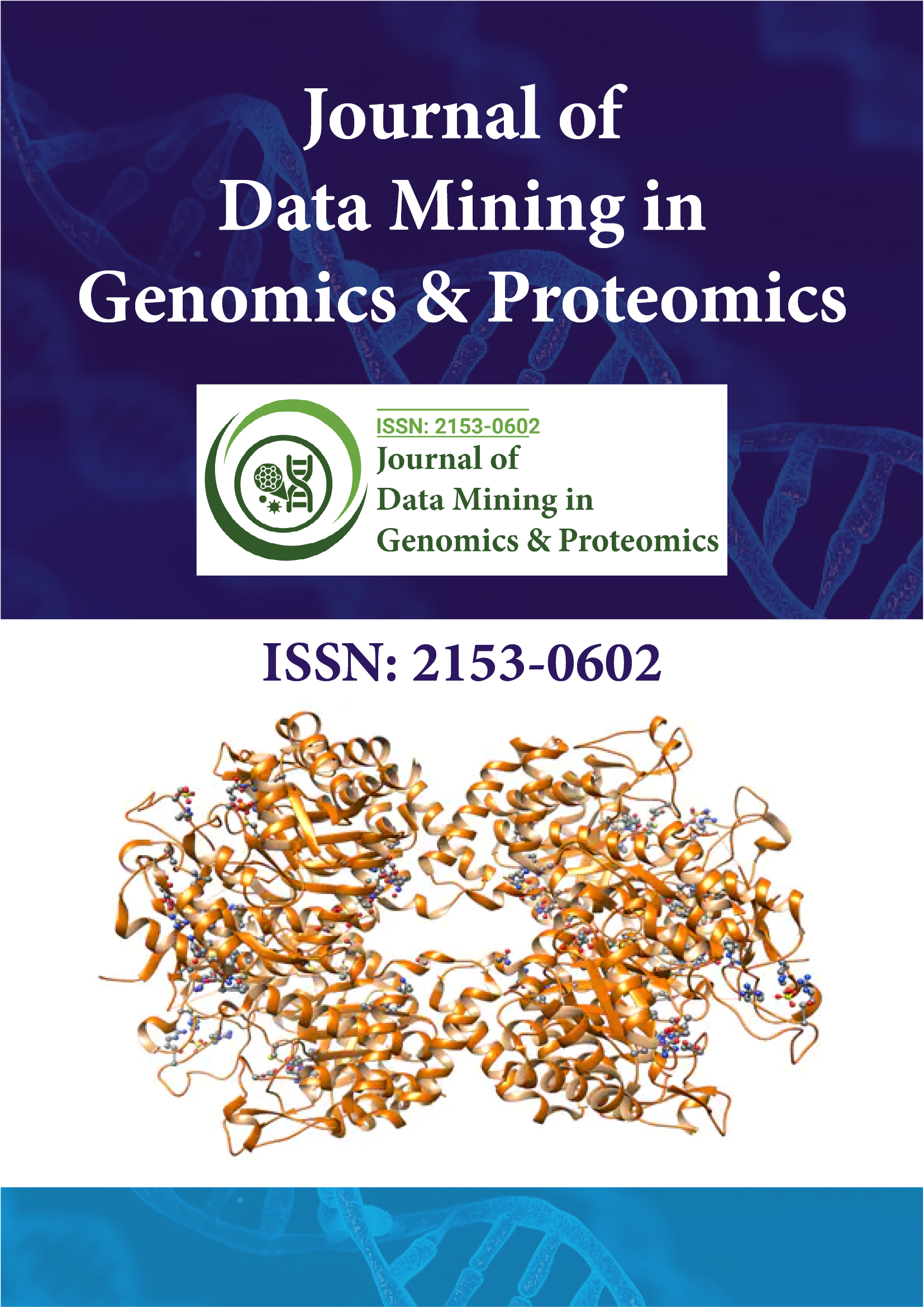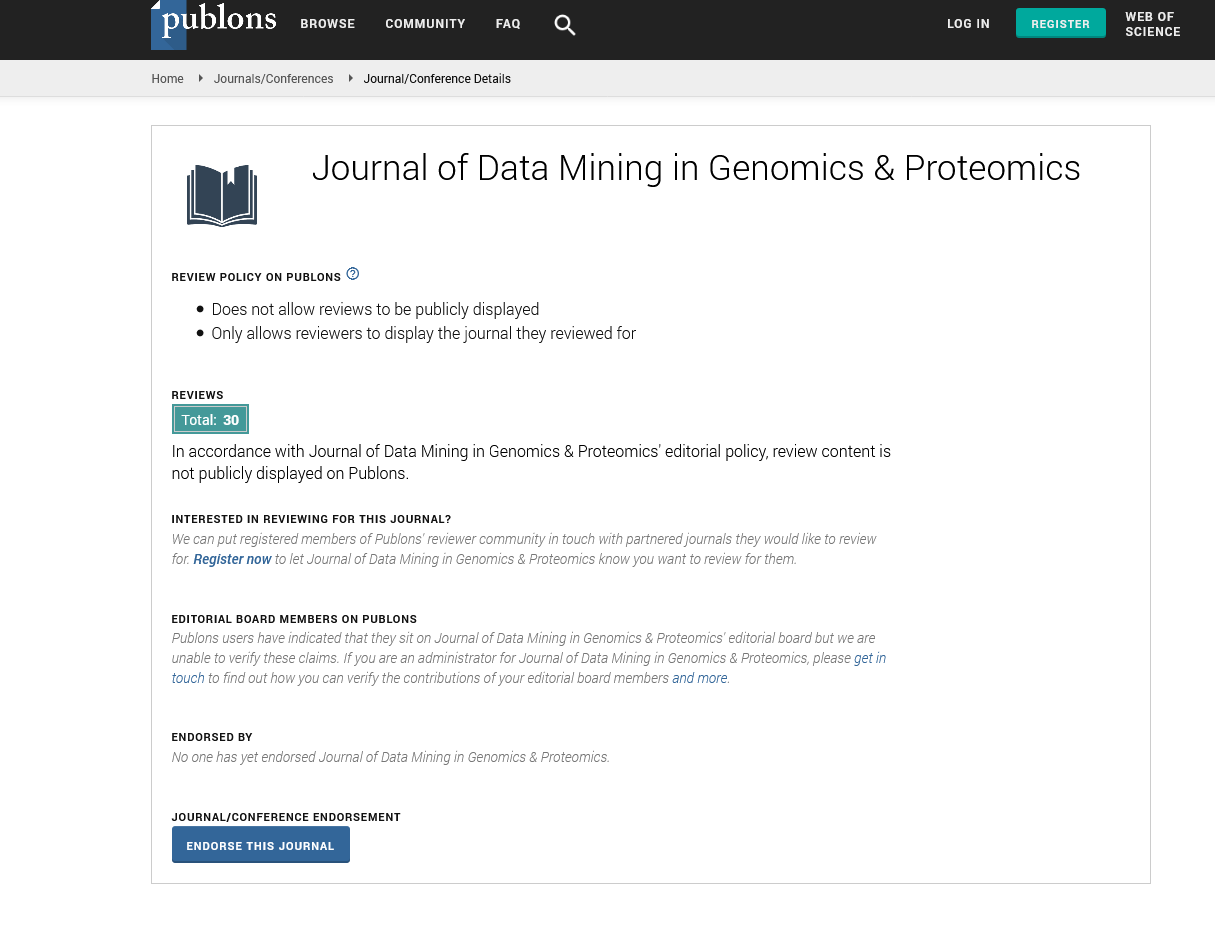Indexed In
- Academic Journals Database
- Open J Gate
- Genamics JournalSeek
- JournalTOCs
- ResearchBible
- Ulrich's Periodicals Directory
- Electronic Journals Library
- RefSeek
- Hamdard University
- EBSCO A-Z
- OCLC- WorldCat
- Scholarsteer
- SWB online catalog
- Virtual Library of Biology (vifabio)
- Publons
- MIAR
- Geneva Foundation for Medical Education and Research
- Euro Pub
- Google Scholar
Useful Links
Share This Page
Journal Flyer

Open Access Journals
- Agri and Aquaculture
- Biochemistry
- Bioinformatics & Systems Biology
- Business & Management
- Chemistry
- Clinical Sciences
- Engineering
- Food & Nutrition
- General Science
- Genetics & Molecular Biology
- Immunology & Microbiology
- Medical Sciences
- Neuroscience & Psychology
- Nursing & Health Care
- Pharmaceutical Sciences
Opinion Article - (2025) Volume 16, Issue 1
Time-Series Proteomic Data Mining for Early Disease Diagnosis and Prognosis
Chen Rong*Received: 24-Feb-2025, Manuscript No. JDMGP-25-29292; Editor assigned: 26-Feb-2025, Pre QC No. JDMGP-25-29292 (PQ); Reviewed: 12-Mar-2025, QC No. JDMGP-25-29292; Revised: 18-Mar-2025, Manuscript No. JDMGP-25-29292 (R); Published: 26-Mar-2025, DOI: 10.35248/2153-0602.25.16.376
Description
Proteomics, the large-scale study of proteins, has become an essential component in understanding the molecular underpinnings of health and disease. As proteins are the functional executors of the cell’s genetic blueprint, alterations in their expression, structure, or interactions often reflect the earliest molecular changes in pathological conditions. In recent years, time-series proteomic data—the longitudinal tracking of protein expression over time—has emerged as a powerful approach to monitor disease progression and assess treatment response. Unlike static measurements, time-series data capture dynamic biological processes, revealing temporal patterns that are critical for early diagnosis and prognosis. Mining such data for meaningful insights, however, poses significant analytical challenges due to its complexity, noise and high dimensionality. This is where data mining techniques, powered by machine learning and bioinformatics, become indispensable tools for unlocking the potential of time-series proteomics in clinical applications.
In time-series proteomics, protein expression is measured across multiple time points from the same biological source—be it blood, tissue, or cell culture—allowing researchers to observe fluctuations in abundance, post-translational modifications, or interaction profiles. These temporal datasets are often generated using high-throughput technologies such as Mass Spectrometry (MS)-based proteomics or Tandem Mass Tag (TMT) labeling combined with liquid chromatography. When applied to disease contexts, such as cancer, neurodegenerative disorders, or cardiovascular diseases, the goal is to identify biomarkers whose expression patterns significantly differ over time between healthy and diseased states. Crucially, changes in protein levels can precede clinical symptoms, making time-series proteomics a promising approach for pre-symptomatic disease detection.
Mining these datasets requires sophisticated algorithms capable of detecting subtle patterns amid noise and biological variability. Traditional statistical methods often fall short in capturing nonlinear relationships and complex interactions. In contrast, machine learning models, particularly unsupervised techniques like clustering (e.g., K-means, hierarchical clustering, dynamic time warping) and supervised learning (e.g., support vector machines, random forests, neural networks), are adept at identifying informative patterns in multidimensional, temporally structured data. For instance, proteins that exhibit synchronized upregulation during early stages of disease can be grouped into functional modules, potentially pointing to early mechanistic shifts.
One widely used approach is Dynamic Time Warping (DTW), which allows for alignment of temporal protein expression patterns that may be out of phase but similar in shape. DTW is particularly useful in heterogeneous datasets where the timing of disease onset may vary across individuals. Similarly, Hidden Markov Models (HMMs) and Recurrent Neural Networks (RNNs)—especially Long Short-Term Memory (LSTM) networks—are effective in modeling sequential data, capturing time-dependent dependencies in protein expression that are critical for accurate forecasting of disease progression. These models learn temporal transitions and can predict future protein expression profiles or likely disease outcomes based on early patterns.
A major focus of time-series proteomic analysis is feature selection—identifying the subset of proteins most relevant to early diagnosis and prognosis. Feature selection algorithms such as Recursive Feature Elimination (RFE), LASSO regression, or more recently, attention-based deep learning models help reduce the dimensionality of the dataset while preserving diagnostic power. Selected proteins can then be validated as biomarker candidates through biological assays or correlated with clinical outcomes such as survival, relapse, or treatment response. Moreover, integrating clinical metadata such as patient demographics, comorbidities and treatment history into proteomic models can enhance the predictive accuracy and relevance of findings. Multimodal learning approaches combine proteomic time-series data with other omics layers, such as transcriptomics, metabolomics, or imaging data, offering a holistic view of disease biology. In personalized medicine, this approach enables risk stratification of patients and customization of therapeutic interventions based on individual molecular profiles.
Importantly, early diagnosis is not the only objective. Prognostic modeling—the ability to forecast disease trajectory, treatment efficacy, or recurrence—relies heavily on longitudinal data. Proteins that change consistently in response to therapeutic intervention can serve as pharmacodynamic markers, while persistent alterations post-treatment may signal residual disease or likelihood of relapse. Time-series analysis thus not only informs diagnosis but also provides real-time insights into disease dynamics and therapeutic monitoring.
Despite its promise, time-series proteomic data mining faces several challenges. Data sparsity, missing time points, batch effects and inter-individual variability can obscure signal detection. To address these issues, researchers employ imputation algorithms, normalization techniques and batch correction methods such as ComBat. Temporal alignment across individuals remains a complex task, especially in diseases with variable onset or progression rates. Cross-sectional models may not be applicable, necessitating personalized or adaptive algorithms. Additionally, validation in independent cohorts is critical to ensure the robustness and reproducibility of predictive models.
Another concern is the interpretability of complex models. While deep learning architectures offer high performance, their "black-box" nature limits biological understanding. To tackle this, explainable AI (XAI) methods are being developed to highlight the most influential proteins and time points contributing to model decisions. Biological pathway enrichment and network analysis can further contextualize the identified proteins, linking them to known disease mechanisms or signaling cascades.
In conclusion, time-series proteomic data mining represents a frontier in precision diagnostics and systems medicine. By capturing the temporal evolution of protein expression, this approach enables the identification of early, dynamic biomarkers and provides actionable insights into disease mechanisms and outcomes. The integration of machine learning, robust data preprocessing and multi-omics perspectives enhances the power of this methodology, paving the way for its translation into clinical practice. As data quality improves and computational tools advance, time-series proteomics holds the potential to revolutionize early detection, prognosis and treatment personalization in a wide range of human diseases.
Citation: Rong C (2025). Time-Series Proteomic Data Mining for Early Disease Diagnosis and Prognosis. J Data Mining Genomics Proteomics.16: 376.
Copyright: © 2025 Rong C. This is an open access article distributed under the terms of the Creative Commons Attribution License, which permits unrestricted use, distribution and reproduction in any medium, provided the original author and source are credited.

